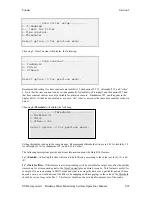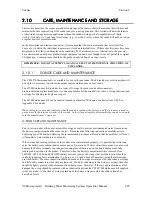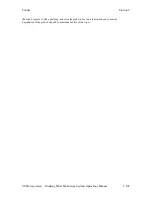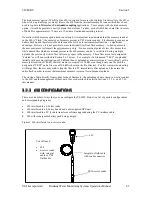
Sondes
Section
2
YSI Incorporated
Drinking Water Monitoring Systems Operations Manual
2-101
1.
Remove all probes other than free chlorine, conductivity, and temperature from the sonde and seal
the vacant ports with the provided port plugs. Leave the electrolyte and membrane in place on the
free chlorine sensor. Fill the calibration cup with tap water and insert the sonde. Make certain the
water level is high enough to completely cover the free chlorine sensor. Seal the vessel to prevent
evaporation of the water. At the end of the storage time, remove the existing membrane and re-
membrane the probe using new electrolyte.
2.
Remove the free chlorine sensor from the sonde leaving the electrolyte and membrane in place.
Store the probe in tap water in a beaker, flask, or other vessel of the user’s choice.
Be sure not to
damage the membrane or the probe tip when placing the probe on the bottom of the vessel.
If possible cover the vessel with parafilm or plastic wrap to minimize evaporation of the water
during long-term storage. Monitor the water level in the storage vessel periodically and replenish
if loss due to evaporation occurs. At the end of the storage time, remove the existing membrane
and re-membrane the probe using new electrolyte.
pH/ORP
The key to pH/ORP probe storage, short or long-term, is to make certain that the reference electrode
junction does not dry out. Junctions which have been allowed to dry out due to improper storage
procedures can usually be rehydrated by soaking the sensor for several hours (overnight is recommended)
in a solution which is 1 molar in potassium chloride (see free chlorine section above for preparation of this
solution). If potassium chloride solution is not available, soaking the sensor in tap water or commercial pH
buffers may restore probe function. However in some cases the sensor may have been irreparably damaged
by the dehydration and will require replacement. It is also important to remember not to store the pH
sensor in distilled or deionized water as the glass sensor may be damaged by exposure to this medium.
The recommended long-term storage method for the pH sensor in the 600DW-B and the 6920DW are as
follows. Remove the probe from the sonde and seal the vacant port with the provided plug. Place the
probe in the storage vessel (plastic boot or bottle) which was in place on delivery. The vessel should
contain a solution which is 2 molar in potassium chloride. Make certain that the vessel is sealed to prevent
evaporation of the storage solution.
AMMONIUM, NITRATE AND CHLORIDE
The active element in the ammonium and nitrate ion selective electrode (ISE) sensors is a polyvinyl
chloride (PVC) membrane that is impregnated with the reagent that provides specificity for either
ammonium or nitrate. The useful life of this sensor can be reduced if the membrane is stored immersed in
water. Thus, storage in dry air is recommended for long term storage. While dry air is slightly preferable
for general storage, the short-term storage of these sensors in the sonde, with the entire sensor array in
moist air, will have no significant detrimental effect on the life of the membrane. Remove the sensor
module from the 6920DW sonde and cover the vacant port with the provided plug. Place the sensor back
in the storage boot that was provided, and set aside in room air.
The chloride ISE sensor utilizes a solid state membrane that provides specificity. For long-term storage, the
module should be removed from the sonde, wiped clean with moist lens cleaning tissue, and placed in its
storage boot to prevent abrasion.
TURBIDITY, CHLORPHYLL, AND RHODAMINE
No special precautions are necessary for either the short or long-term storage of the chlorophyll, rhodamine
WT, and turbidity probes. However, for long-term storage, the user may wish to remove the probe from
Содержание 600DW-B
Страница 3: ......
Страница 239: ...Principles of Operation Section 5 YSI Incorporated Drinking Water Monitoring Systems Operation Manual 5 26...
Страница 251: ...Warranty and Service Information Section 8 YSI Incorporated Drinking Water Monitoring Systems Operations Manual 8 4...
Страница 259: ...Required Notice Appendix B YSI Incorporated Drinking Water Monitoring Systems Operations Manual B 2...
Страница 264: ...EMC Performance Appendix D YSI Incorporated Drinking Water Monitoring Systems Operations Manual D 2...
Страница 268: ...Specifications Appendix E YSI Incorporated Drinking Water Monitoring Systems Operations Manual E 4...
Страница 297: ......
















































